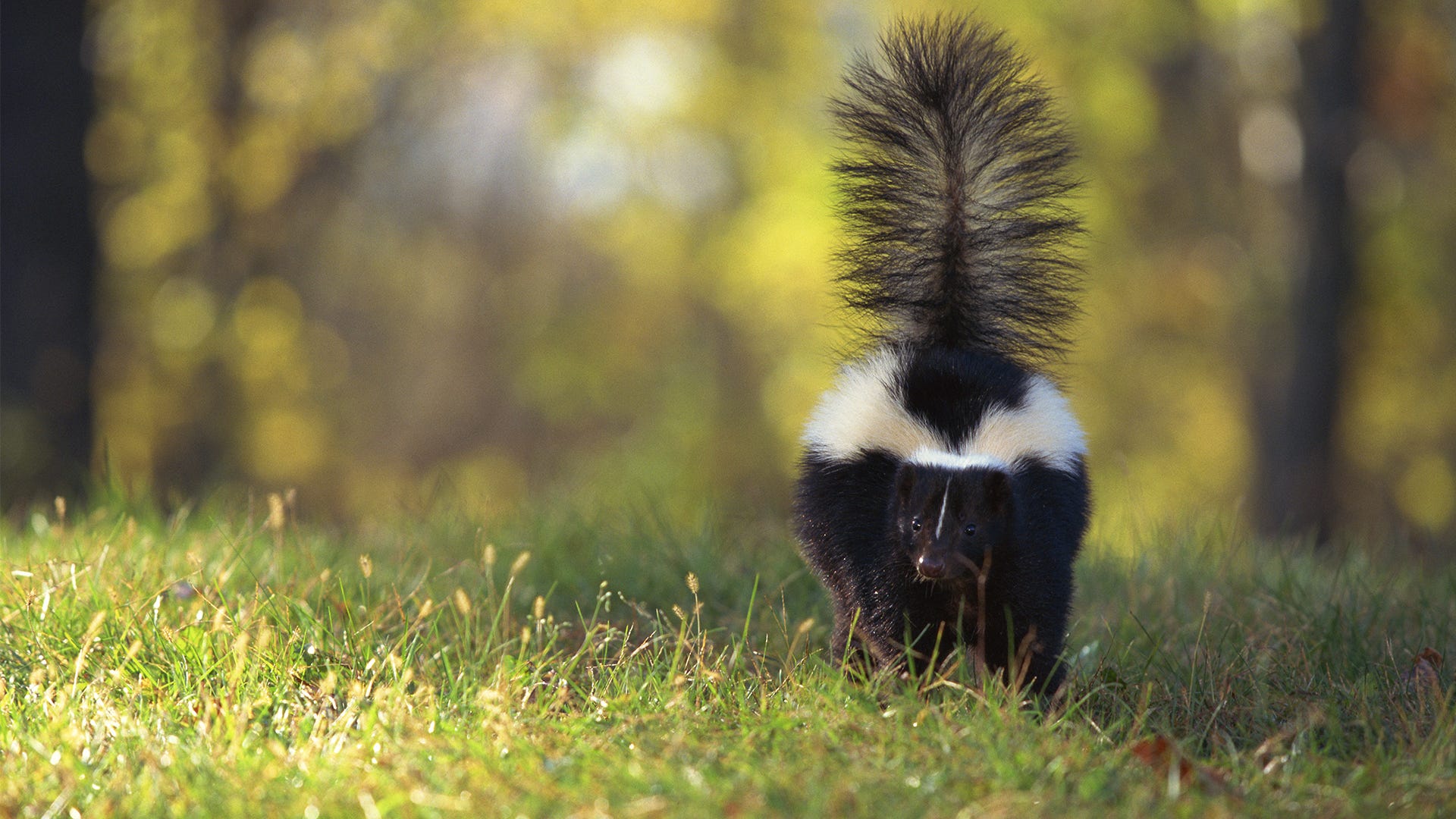Skunk spray range is a fascinating topic that combines wildlife behavior, chemistry, and environmental science. Skunks are nocturnal creatures known for their potent defense mechanism, and understanding their spray range can help humans coexist more peacefully with them. Whether you're a wildlife enthusiast, a gardener, or simply curious about these misunderstood animals, this article dives deep into the science behind skunk spray, its range, and how to manage encounters effectively. Discover the answers to common questions and gain actionable insights to protect yourself and your property from skunk-related issues.
Skunks are often misunderstood due to their strong-smelling spray, but they play a vital role in ecosystems by controlling insect populations. Learning about the skunk spray range not only helps reduce human-wildlife conflicts but also promotes respect for these creatures. This guide will explore the factors that influence the range of skunk spray, its effects on humans and animals, and strategies to mitigate its impact. By the end of this article, you'll have a comprehensive understanding of skunk behavior and how to handle encounters responsibly.
As skunk encounters become more frequent in urban and suburban areas, understanding skunk spray range has become increasingly important. This article provides valuable information for homeowners, outdoor enthusiasts, and pet owners who may come across skunks in their daily lives. With expert advice and practical tips, you'll be well-equipped to deal with skunk-related challenges while fostering a harmonious relationship with nature.
Read also:Taylor Swifts Melodic Calendar Discover Songs Featuring May In The Lyrics
What Is the Average Skunk Spray Range?
Skunks are well-known for their ability to spray a foul-smelling liquid as a defense mechanism. On average, a skunk can spray its potent secretion up to **10-15 feet** (3-4.5 meters). However, the actual skunk spray range can vary depending on factors such as the skunk's size, health, and environmental conditions. In some cases, skunks have been known to spray even further, reaching distances of up to 20 feet (6 meters). Understanding the skunk spray range is essential for avoiding unpleasant encounters and minimizing the impact of skunk spray on humans and pets.
How Does Skunk Spray Range Affect Human-Wildlife Interactions?
The skunk spray range plays a significant role in human-wildlife interactions, particularly in suburban and rural areas where skunks are more common. When a skunk feels threatened, it will typically give warning signs such as stomping its feet, hissing, or raising its tail before spraying. If these warnings are ignored, the skunk may unleash its spray, which can cause discomfort, nausea, and even temporary blindness if it comes into contact with the eyes. Knowing the skunk spray range and recognizing warning signs can help prevent unwanted encounters and reduce the risk of being sprayed.
Why Is Skunk Spray So Effective Over Such a Long Range?
Skunk spray is composed of sulfur-containing chemicals called thiols, which are responsible for its potent odor. These compounds are highly volatile, meaning they can evaporate quickly and travel through the air over significant distances. This volatility contributes to the skunk spray range, allowing the spray to reach its target effectively. Additionally, skunks have specialized glands that allow them to aim and control the direction of their spray with remarkable accuracy. This combination of chemical potency and precise delivery makes skunk spray an exceptionally effective deterrent against predators.
Factors That Influence Skunk Spray Range
Several factors can influence the skunk spray range, including the skunk's physical condition, the angle of spraying, and wind conditions. A healthy adult skunk is more likely to have a longer spray range compared to a juvenile or sick skunk. The angle at which the skunk sprays can also affect the distance the spray travels. For example, spraying downward may result in a shorter range due to gravity, while spraying horizontally or slightly upward can increase the range. Wind direction and speed can further impact the skunk spray range by carrying the spray farther or dissipating it more quickly.
How Can You Protect Yourself from Skunk Spray?
Prevention is key when it comes to avoiding skunk spray. To minimize the risk of being sprayed, it's important to understand skunk behavior and take precautions during outdoor activities. For instance, keeping your pets on a leash in areas where skunks are known to inhabit can help prevent accidental encounters. If you spot a skunk, give it plenty of space and avoid sudden movements that might provoke it. In addition, securing trash cans and removing potential food sources can discourage skunks from entering your yard.
What Should You Do If You Get Sprayed by a Skunk?
If you or your pet gets sprayed by a skunk, prompt action is necessary to neutralize the odor effectively. The first step is to avoid washing the affected area with water alone, as this can spread the thiols and worsen the smell. Instead, use a specialized skunk odor remover or a homemade solution consisting of hydrogen peroxide, baking soda, and dish soap. Apply the solution generously and let it sit for several minutes before rinsing thoroughly. Repeat the process if necessary until the smell is neutralized.
Read also:Maximizing Your Digital Experience The Ultimate Guide To Cable Internet Bundle
Understanding Skunk Behavior and Spray Patterns
Skunks are generally peaceful animals that prefer to avoid confrontation. They only resort to spraying as a last line of defense when they feel genuinely threatened. Understanding skunk behavior and recognizing the warning signs can help you avoid triggering a spray response. For example, skunks often stomp their front feet and arch their backs as a signal to back off. If you notice these behaviors, it's best to retreat slowly and give the skunk plenty of space to retreat.
Can Skunk Spray Damage Property or Clothing?
While skunk spray is primarily known for its unpleasant odor, it can also cause damage to certain materials, particularly fabrics and surfaces sensitive to sulfur compounds. Clothing that comes into contact with skunk spray may require multiple washings or professional cleaning to fully remove the smell. In some cases, the thiols in skunk spray can discolor fabric or cause staining. To protect your belongings, it's important to act quickly and follow proper cleaning procedures after a skunk encounter.
Skunk Spray Range in Urban and Suburban Environments
As human development encroaches on natural habitats, skunks have adapted to living in urban and suburban areas. This increased proximity to humans has led to more frequent skunk encounters, making it crucial to understand skunk spray range in these environments. Homeowners can take steps to reduce the likelihood of skunk encounters by sealing entry points to their homes, removing potential den sites, and using motion-activated lights to deter skunks from entering their yards. By taking proactive measures, you can minimize the risk of skunk-related issues while allowing these animals to coexist peacefully in shared spaces.
What Are the Long-Term Effects of Skunk Spray?
While the immediate effects of skunk spray are unpleasant, the long-term consequences are generally minimal. Once the thiols are neutralized, the odor will dissipate, and most surfaces will return to their original state. However, in rare cases, skunk spray can cause respiratory irritation or allergic reactions in sensitive individuals. If you experience persistent symptoms after a skunk encounter, it's important to seek medical attention. Additionally, pets that have been sprayed should be monitored for any signs of discomfort or illness and treated promptly if necessary.
Conclusion: Embracing Coexistence with Skunks
Understanding the skunk spray range is an essential step in fostering a harmonious relationship with these fascinating creatures. By learning about skunk behavior, recognizing warning signs, and taking preventive measures, you can minimize the risk of unpleasant encounters while appreciating the vital role skunks play in maintaining ecological balance. Whether you're a homeowner, a nature lover, or simply someone who wants to avoid skunk spray, this guide provides the knowledge and tools you need to navigate skunk-related challenges effectively.
Table of Contents
- What Is the Average Skunk Spray Range?
- How Does Skunk Spray Range Affect Human-Wildlife Interactions?
- Why Is Skunk Spray So Effective Over Such a Long Range?
- Factors That Influence Skunk Spray Range
- How Can You Protect Yourself from Skunk Spray?
- What Should You Do If You Get Sprayed by a Skunk?
- Understanding Skunk Behavior and Spray Patterns
- Can Skunk Spray Damage Property or Clothing?
- Skunk Spray Range in Urban and Suburban Environments
- What Are the Long-Term Effects of Skunk Spray?
By exploring the intricacies of skunk spray range, we can gain a deeper appreciation for these remarkable animals and develop strategies to live alongside them responsibly. Whether you're dealing with a skunk encounter or simply curious about skunk behavior, this guide offers valuable insights to enhance your understanding and promote peaceful coexistence.


